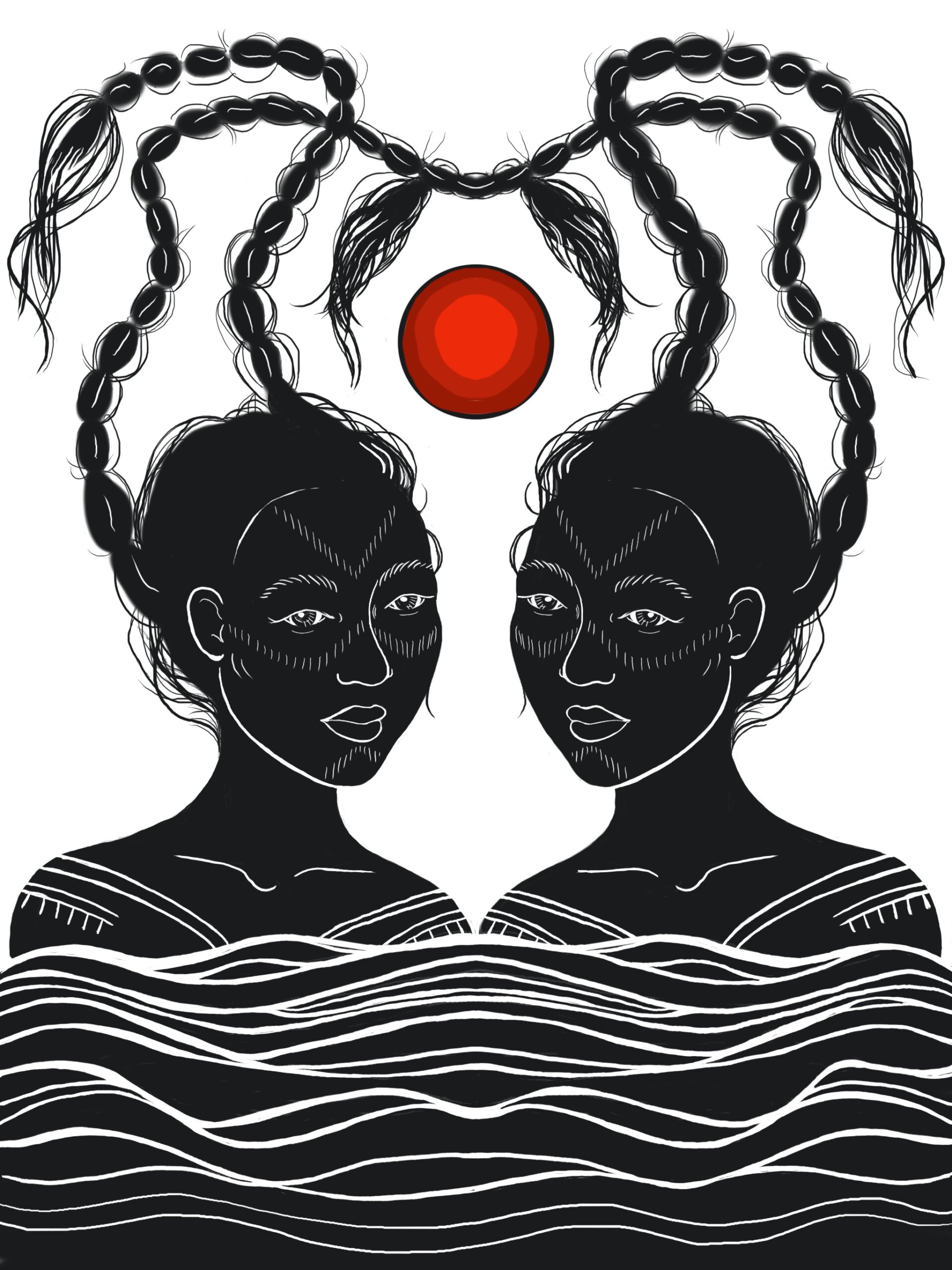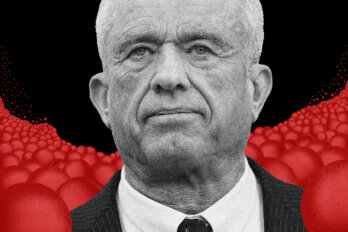In pre-christian times, the markers of the passage of time for Inuit included:
The tides (every six hours)
The sunrise and the moonrise (every twelve hours, outside of the extremes of each in the summer and winter)
The moon himself (evolving every week)
Piturniq, when tides are highest and lowest at the new and full moons (every two weeks)
The seasons (cycling every two months)
Winters, which are so prominent and long in the Arctic
Uteruses (cycling every month in times of plenty.)
I have two tattooed lines across the tops of my hand to thank sila, the universe, for giving me the moment when all time stopped as a polar bear’s eyes directly engaged with mine. She had stood up to look through the upper-floor window of our cabin, and I had unwittingly stuck my head out. Her glistening black nose was just a few centimetres from mine. My tiny hands and her giant paws gripped the same piece of wood.
I was filled with admiration; she was so different from most animals I know. Her ears were perked forward, and I felt no animosity from this massive being. Underneath her translucent white hairs, I could see her black skin. Her nose flared with huge flexibility as she breathed my essence in. Her eyes filled with curiosity—So this is human, I could feel her think. I saw her recognizing my smell from other places she had explored. She had never had to fear a thing in her life, and she studied me with a type of intelligence I could only grasp at.
In the midst of this moment, I felt my humanness, the nanoq felt her nanoqness, and each of us recognized that even though our worlds were now touching, we were completely separate beings. This forever moment broke as my husband’s feet caused the bottom rungs of the ladder that leads up to our bed to creak. I snapped my head back inside.
“We have to kill her,” I whispered, and Stiffi nodded, handing me the rifle. I pulled the bolt of the gun back and pushed a bullet into the chamber of the gun. “Warning shot,” Stiffi whispered. I fired a shot over the nanoq’s head. The incandescent light of gunpowder firing out of the barrel ripped into the night as the sound of the bullet whizzed toward the sea. The nanoq dropped down on all fours. She didn’t know whether the big sound came from in front of or behind her.
All conscious beings waited.
She stood back up, and it looked like she might lean her front paws into the wall to look through the window again. I loaded the rifle once more and fired straight into the nanoq’s chest. The cabin lit up again with the flash of gunpowder, and I saw our sleeping kids in my peripheral vision. The nanoq again dropped to all fours, turned around, and lolloped into the darkness
How was the nanoq still alive? Two more shots on each side of her head missed. Just then the nanoq slumped over, barely visible in the shadows of the night, about twenty metres from the cabin. She seemed to be dead now.
With a total of four rifle shots fired right over the kids’ heads in our bed, how were they still asleep? In retrospect, I saw that our kids have the ability to use sleep as a survival technique; their calmness allowed me to act swiftly around them, and they endured no trauma in their wakeful lives. Maybe the spirits held the kids in sleep.
Menstruation is the invisible blood, the unspoken space between us, a pulled migration, the marginalized swelling. In Kalaallisut, my mother tongue, the word for menstruation is aaqarneq, which literally translates as “to have blood.” Menstruation is a direct, physical, and mental connection to sila—our bodies and minds are a part of the greater environment. Sila is a sentient force in Inuit ontology: the same word means the environment and intellect simultaneously. Inuit see menstruation as an effect of a natural law dictated by sila and believe that, as people who menstruate, we are all subject to that law, alongside all other mammals.
When you are on the land, and you are the only humans all around you, it is easy to understand that your sense of reality is only one of the multitudes of realities. As we leak and gush blood between our legs, our bellies bloating, and we feel all the various aches and emotions of menstruation, our perception of our immediate environment is heightened; blood deepens our understanding of the multitudes.
In the summertime, my youngest and I love to walk down to the low-tide flats and feed scrap fish bones to the krill. The prevailing sound is of the tiny creatures masticating and wiggling around in their seawater puddles. It is mind boggling to realize there are enough krill to feed not just one bowhead whale on a daily basis but all the bowhead whales in the whole Arctic.
In those same moments, as the tide spills forward, reclaiming the wet sand and gravel as its own, we marvel at our ability to bring our air world within millimetres of the seawater world. If we kneel at the water, sometimes we can just about kiss fish as they chase the warm, shallow creep of the tide. We could never really know their world, as they could never know ours, but we’re able to bring our realities to touch.
There’s a stream not too far from our cabin, at the inner part of Tikkuut, about twenty-three kilometres from Iqaluit, that we haul drinking water from. It bubbles down a steep hill and tastes sweet, earthy, and full of minerals. When we go there, we often stay a while to visit the water, sniffing the air, plucking edible plants and berries, and bathing.
One day, the fog was so thick we couldn’t see more than a few metres around us. We made the short expedition to the stream with trepidation, my eldest and I carrying rifles and alternating between the front and back of the pack while the two younger kids were in the middle. My husband had to be in town that day and wasn’t with us. We quickly filled our water containers and headed back home. Just as we crested the hill, a big rumbling boom stopped us in our tracks. I cursed my dull human senses for not being able to pick up on what was making that awful noise. Even though we couldn’t see it, our realities were touching.
I remembered the stories my friend Miali Pitsiulaaq and many other Inuit tell of coming across familiar but incongruently placed people on the land. They say never to follow a figure that looks like someone you know who isn’t on the trip with you because it is a shape-shifter spirit luring you away. I thought of the stories I have heard of caribou with their eyes turning up and down instead of side to side; the misaligned eyes are a sign that it is a spirit, not an actual caribou. And I thought about that one time my echo came back to me as “help me help me help me” instead of what I had actually yelled out. I realized that our rifles were almost useless at this moment. I wasn’t afraid of something that would attack us. I was afraid of something that could draw us away from everything we know. Finally, the sound dissipated, though the fog never did. We inched our way back to the cabin and stayed inside for the rest of the day.
In the summer, we access our cabin by boat. Our spot has an inlet on the south side that is protected from most winds. It’s also deep and close enough to shore that we can anchor our boats and they bob there safely for days on end. It is just the southeast winds that are worrisome for us—there’s nothing but open water in that direction, so the waves and the wind can make for trouble.
We go to our cabin as often as we can manage with our busy careers, kids’ sports activities, and variable weather: we are weekend and holiday warriors. One night when my mother was visiting a few years ago, my husband had to leave for town earlier than us. Soon after he left, the line between land and water on the other side of the bay got all hazy—a sure sign the weather was taking a turn for the worse. The southeast winds picked up, and we watched big U-shaped waves amass as the tide rose. We had two choices: wait out the storm at the cabin or leave for town in our boat, hugging the shoreline to avoid getting pulled out into the sea. I had a hard time deciding—maybe there was too much static interference from the outside for me to really listen inward. It should have been a time that I slowed down and listened to the rush of my own blood before I made decisions. My mom and I packed the boat in case we needed to make a last-minute getaway.
The sky blackened with heavy clouds, and the rain came down sideways. I stood anxiously beside the boat as the water lapped all around it. All of a sudden, two big waves came one after the other, crashing over the boat. After making sure everyone was safe, my mom and I threw all our packed things onto the shore, rushing to make sure our clothes and food were saved. We ran up to the cabin with everything and the kids in tow, and once we were back inside, my mom got a soup going to warm everyone up. I ran back outside to try and save the boat. The motor, most of all, needed to stay dry. Standing thigh deep in the water, I tried to push the boat around so that it would float. I got inside and bailed water out. I tugged on the motor, hoping for some movement. Eventually, I climbed onto the boat’s cabin, the motor completely ruined by this time. I begged for the tide to start retreating again. I was angry at myself for being at the brink of such danger. I wanted Nuliajuk, our sea deity, to grant me mercy. All these years later, I realize she did, by never giving us a chance to push our boat off the shore. We were safe in our little house after all.
Imagine if I had been more visceral, more trusting of my insides, more bloody in those moments when I felt deep fear on the land—when I was face to face with the unknown and with beings far more powerful than me. My blood and my acceptance of how it speaks to me have become the sources of my courage, my decisiveness, my quelling of self-doubt.
For a few years, my blood spoke to me about something that was wrong inside of me. At first, I didn’t hear it, but it used as many sensations as it could muster until I paid attention. It raised its own pressure, then deposited its excess in my kidneys. The excess caused me to collapse on the floor in pain; this happened on and off for about ten months. My blood sent me into spirals of sadness and a mental heaviness that I had to fight to stay on top of.
I eventually learned I had hyperparathyroidism, a condition that leads to an imbalance of calcium in the bloodstream. The doctors sent me south for kidney surgery, and still my blood wasn’t finished talking to me. They put me on an intravenous drug to try to correct things, but my blood rejected the medicine. Every time I was given the drug over the period of half a year, I often spent a week or more writhing in bed, getting sweats and chills, and vomiting. A chemical-flavoured anxiety made me cry uncontrollably.
My blood never stopped telling me something was wrong inside me until I was finally taken for another surgery, where they slit my throat open and removed a little tumour the size of a button. As I recover, I am unpacking the information my body gave me. I had internalized the message that to understand mental illness, I need only to probe my brain and pay attention to my environment. I hadn’t known to listen to my blood.
Many people almost automatically and unquestioningly speak of various aspects of Indigenous cultures being “traditional.” This causes one to see Indigenous cultures as paused in time, or authentic only if they do not incorporate so-called contemporary experiences. Allison Akootchook Warden, an Inupiaq artist and a personal friend, introduced me to the term transcustomary. It means that practices, events, material items, and bodies are allowed to exist throughout time, even if there has been a blanket of colonization over us for part of the time. Menstruation is transcustomary. It continues to remind us that we are still here and attuned to the earth despite all the efforts to kill us as Indigenous people. It has not changed because of colonization and still exists despite the imposition of the Gregorian calendar.
If we focused on menstruation as a physical manifestation of both individuality and collectivism, if we understood it as a marker of time, and if we saw it as a way that a large portion of our population transmits signals from the environment to the functioning of our bodies, our society would operate in a much different way.
I think about the infinity that my body holds inside, like two mirrors facing each other; my menstruation is directly connected to my mother’s, my grandmother’s, and to all the ancestors forever, as it is connected to my descendants as far as they may endeavour to exist. We are all continuous with one another by the stains of blood between our legs.
My eldest daughter, Akutaq, and I alternate in our cycles: one of us is usually menstruating when we experience piturniq, the two times of the month when the tides are at their most extreme. She menstruates during the full moon and I take the new moon. She takes the solstice and I take the equinox. I wager that many Inuit menstruate when the tides are low enough to expose the delicious clams in the far-reaching flats. We know the deep gush of blood as we wait for the final flush of seawater to leave the clam beds.
I grow frustrated with how menstruation is often spoken about today. When any discussion of the cycle is boiled down to the mechanics of fertility, for example, the heteronormative, patriarchal norms of our colonizers take over. The reality is, we menstruate before we bear children. We menstruate when we want children, we menstruate when we don’t want children, and we menstruate after we have had children.
I cannot speak for trans experiences of menstruation. Not all women menstruate, some men menstruate too, and so do some non-binary folk. Many people all around me and very close to me also suffer deeply as they menstruate. My Inuk upbringing tells me that I need to listen to others tell these stories and not tell them on their behalf.
At one point, when Akutaq was navigating through twelve to eighteen days of menstruation at a time, immense, painful cramping, and a recent diagnosis of polycystic ovary syndrome, I helped make way for the openness and forwardness about her bleeding that she needed so that she could receive medical help and holistic support. She speaks frankly about menstruation to people of all genders, professions, and age groups, with no stigma, in a way my peers and I were not allowed to at her age.
The menstrual pain that she and many other people deal with has a long history of being dismissed, diminished, and ignored by patriarchal Western medicine. In many societies and religions, menstruation is treated as dirty and embarrassing, when in fact it is the opposite. Inuit women of childbearing age have been told for a very long time that they should not eat seal liver because of the general level of heavy metals in them, so that their babies do not get contaminated in utero or through breast milk. Meanwhile, seal liver is one of the richest, most nutritious foods for menstruating, pregnant, and breastfeeding people from our culture. Menstruation gives us the ability to see and feel components of our bodies in heightened ways. Prior to colonization, people took leave of their everyday activities to rest, recover, and plan for the next month while they menstruated. Sometimes, this involved spending time alone. Major family and community decisions were made after a menstrual cycle ended.
In our stories, the sun and the moon began as incestuous siblings. The sister ran through a darkened land to get away, a bright torch lighting her way, and her brother chased her, carrying just a dim light. They lifted up off the ground and flew into the sky, and the sister became Seqineq, the sun, and the brother became Aninngaq, the moon. In the many ways this story is utilized throughout our culture, it means that the brother, in all his waxing and waning, takes responsibility for the tides and for menstruation. In the times before industrialized menstrual products, Inuit men prepared rabbit skins for women to use because of this responsibility.
As a thirteen-year-old, I could not abide the idea that babies are born in sin and don’t go to heaven unless they are baptized. It made me reject Christianity. Since that time, I have filled my household with Inuit celebrations, rituals, and spiritual understandings. I am not trying to cast my family back to a time before colonization but to live as a modern non-Christian Inuk.
In modern as in pre-Christian times, Inuit observe puberty with celebrations. Children experience massive biological and hormonal changes that spell the end of childhood and the beginning of the training ground for adulthood. Nowadays, the puberty rites, at least in Greenland, where the majority of my family lives, are cloaked in Lutheran confirmation ceremonies, where thirteen-year-olds wear white clothing and profess their devotion to Christ and his teachings. Before Christianity, children were given tattoos to remember this time of their lives when they are given more responsibilities in running their households.
When Akutaq began menstruating, at the age of twelve, and my son, Igimaq, started growing taller and broader at the same age, our dear friend Becky Mearns came over with poke-and-stick tattoo equipment. We feasted with fermented fish and mattak—whale skin. My children and I received matching line and dash tattoos. It was monumental and understated at the same time—a perfect life marker for our family. At the time of Akutaq’s tattooing, she was the youngest Inuk we knew anywhere to get tattooed. It is now commonplace at the high school in Iqaluit and on the streets all around the Arctic to see young teens marking their skin as we did. I look forward to going through this puberty rite with Naja, my youngest child.
Colonization has made a taboo and a financial tariff of menstruation. Not just for us as Inuit but for everyone. We know this as we stand in line to pay multinational cosmetic companies for their plastic menstrual products. We know this as our modern work schedules ignore menstrual cycles. We understand that as we get no rest when piturniq and Aninngaaq call on our bodies.
Imagine how we could use menstruation as a planning tool. Imagine if we watched and felt our human bodies fall into the rhythm of the water and the moon together. Imagine people who don’t menstruate paying it explicit respect. Imagine using the physicality of our bodies to connect to all the cycles of sila.
It is entirely possible for us to realize that we stand on the edge of one reality and we very nearly kiss another. If we embrace the fullness of what our bodies can tell us, we could step through that boundary and take our place in the wobble of the earth again.
Adapted from a 2022 speech given at Nuit Blanche in Toronto.




